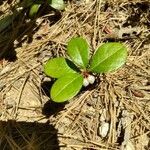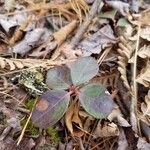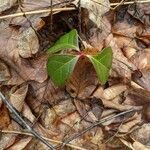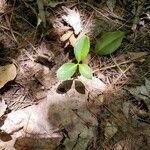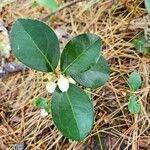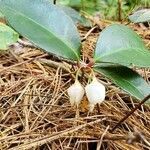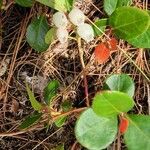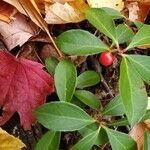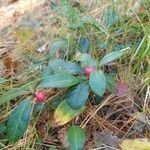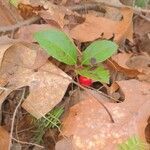Subshrubs, creeping, not mat-forming, rhizomatous or stoloniferous; adventitious roots absent. Stems decumbent, branches ascending, 5-20 cm, lanate, glabrescent. Leaf blades (pale green abaxially, bright green, glaucous adaxially), obovate to oval or orbiculate, 1.5-4.5 cm, base cuneate to rounded, margins serrate (teeth bristle-tipped), (slightly revolute), apex acute to rounded or obtuse, rarely mucronate, surfaces sparsely hairy (hairs unbranched). Inflorescences axillary, solitary flowers or with 2-3 nodding flowers per node; bracts reddish, cordate, distinctly concave, 1-2 mm, not exceeding sepals, ciliate marginally. Pedicels pinkish, 1-3 mm, lanate; bracteoles absent. Flowers: sepals 5, connate 1/2 to nearly their entire lengths, white, cordate, 2.5-3.5 mm, ciliate marginally; petals 5, connate nearly their entire lengths, white, 8-10 mm, adaxial surface lanate-hairy, corolla urceolate, lobes 1 mm; filaments (pinkish), slightly widened proximally, lanate-tomentose; anthers with 2 apical awns (awns not bifurcating), dehiscent by subterminal pores proximal to awns. Fruits bright red to reddish violet, 6-9 mm wide. 2n = 44, 88.
More
Leafy stems suberect from a horizontal rhizome, 1–2 dm, with a few lvs crowded near the top; petioles 2–5 mm; blades elliptic or oblong to rarely subrotund, 2–5 cm, entire or crenulate, glabrous; fls 5-merous, on nodding pedicels 5–10 mm; cal saucer-shaped; cor barrel-shaped, 7–10 mm, the rounded lobes 1 mm; fr bright red, 7–10 mm; 2n=44, 88. Dry or moist woods in acid soil; Nf. to Man., s. to Va., Ky., n. Ind., Minn., and in the mts. to Ga. and Ala. July, Aug.
A small shrub. It grows 15 cm high and spreads 90 cm wide. The leaves are glossy green and 5 cm long. They turn red in winter. The flowers are white or pale pink and in long clusters. The fruit is 12 mm across and red. The fruit has a fragrance when crushed.
Mixed woodlands, mesic forests, dry, acidic woodlands, powerline rights-of-way, roadbanks, old pastures, coniferous woodlands, maritime heathlands, montane heath balds, bogs and fens, usually in acidic and/or sandy soils; at elevations up to 1,500 m.
More
It is a temperate plant. It grows in poor soils and in forest clearings. It suits moist, shady locations. It is very cold hardy. It can tolerate drought once established. It can grow on poor acid soils. It suits hardiness zones 4-9.
